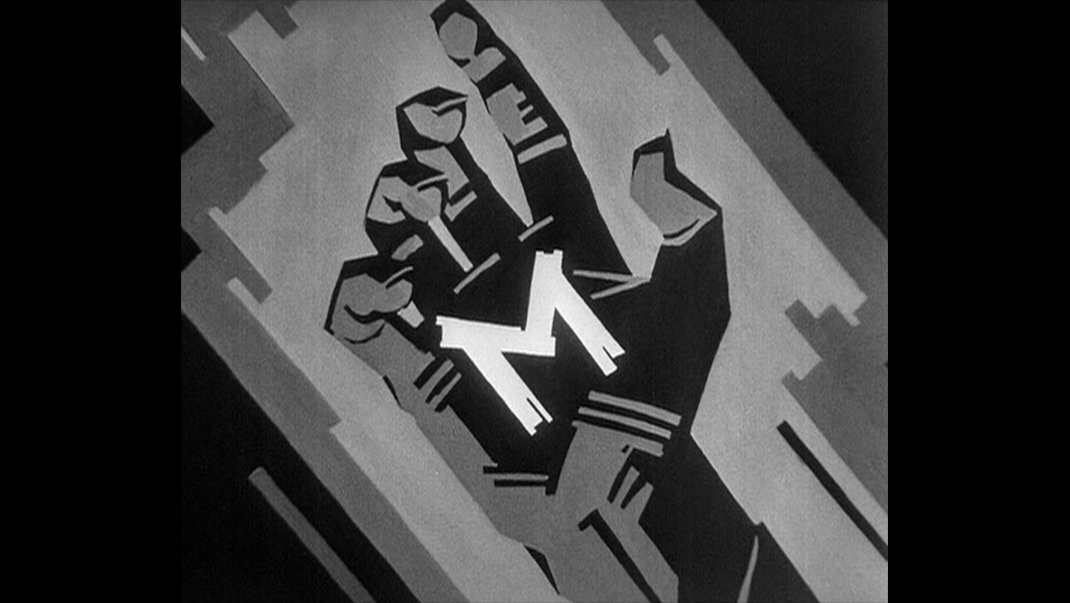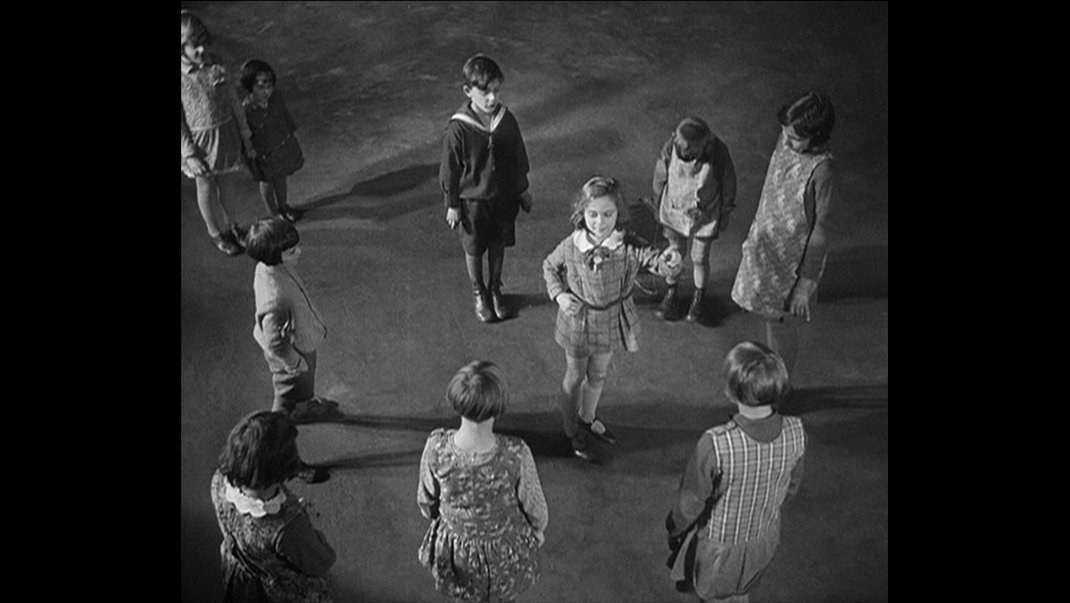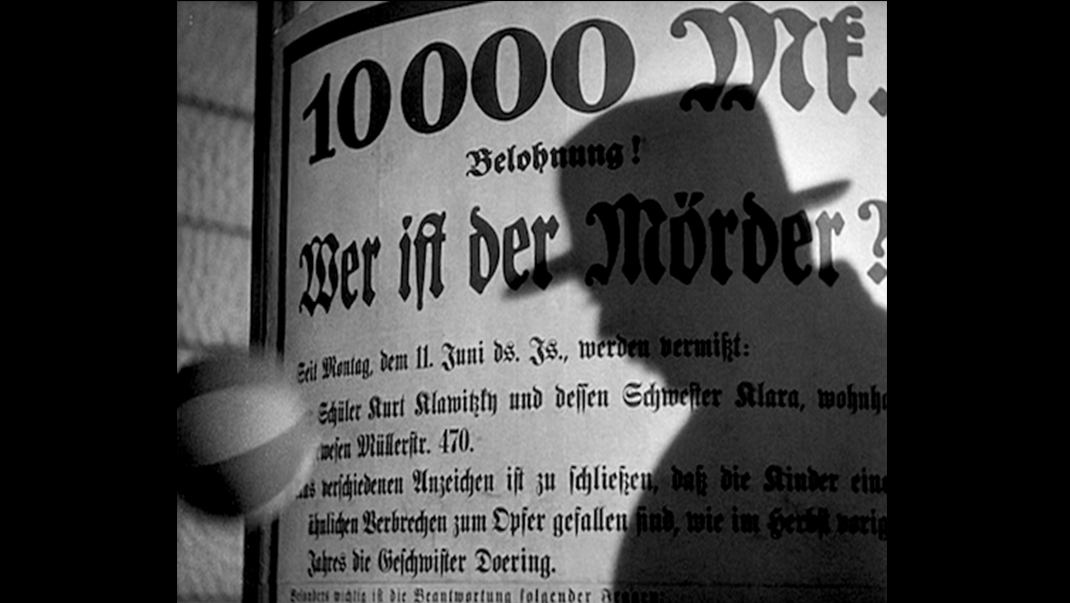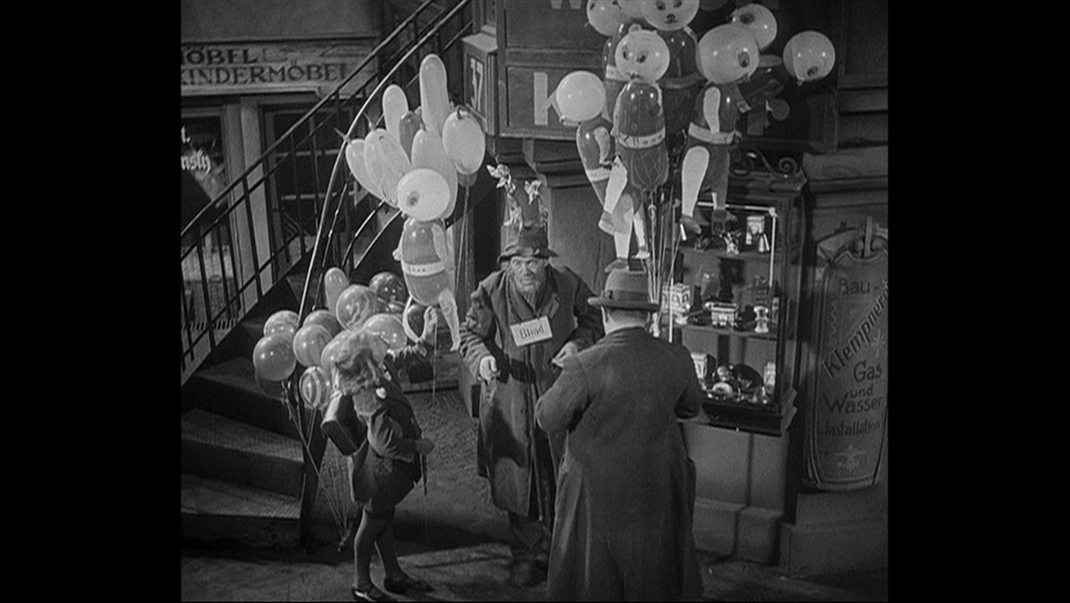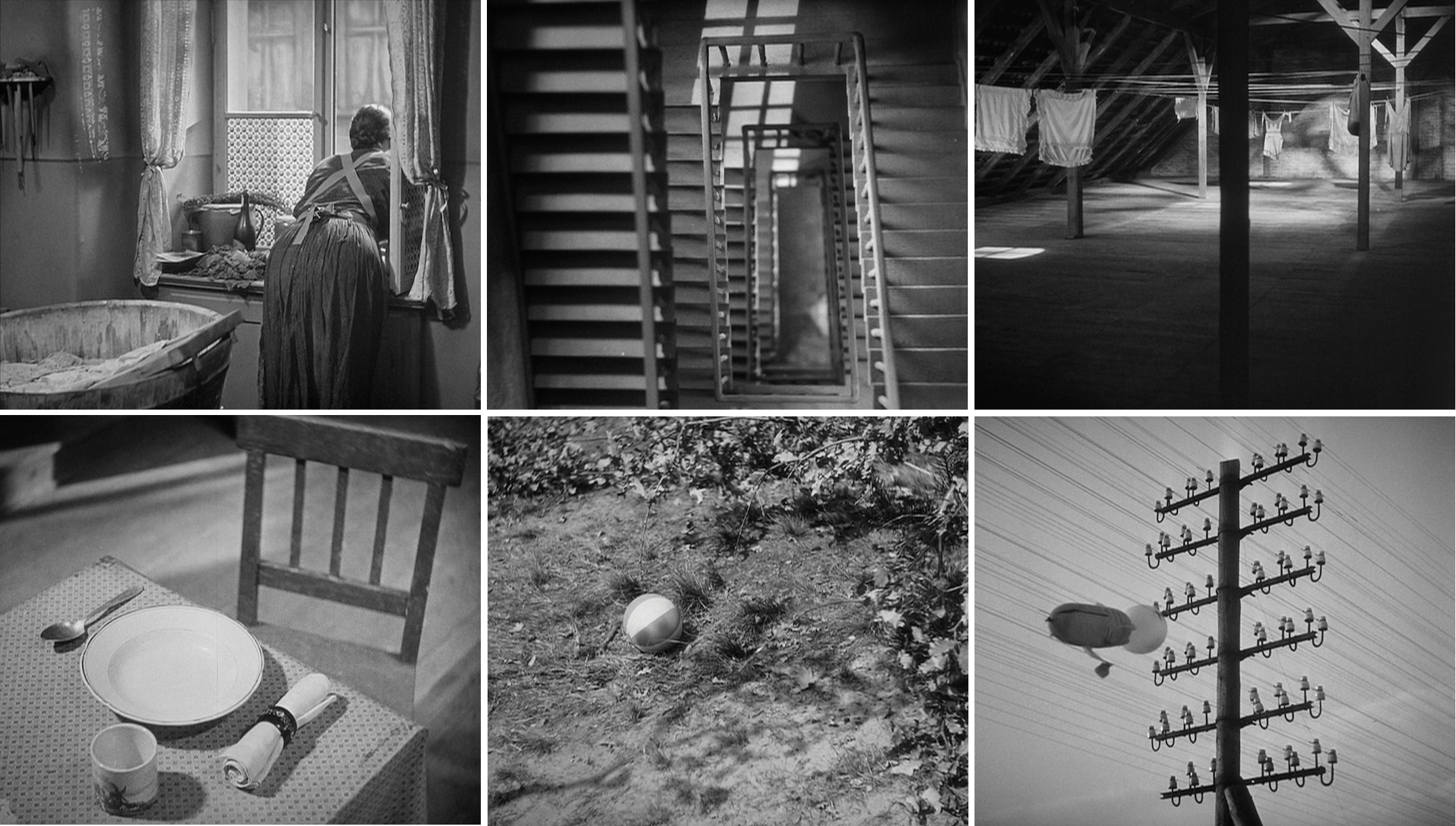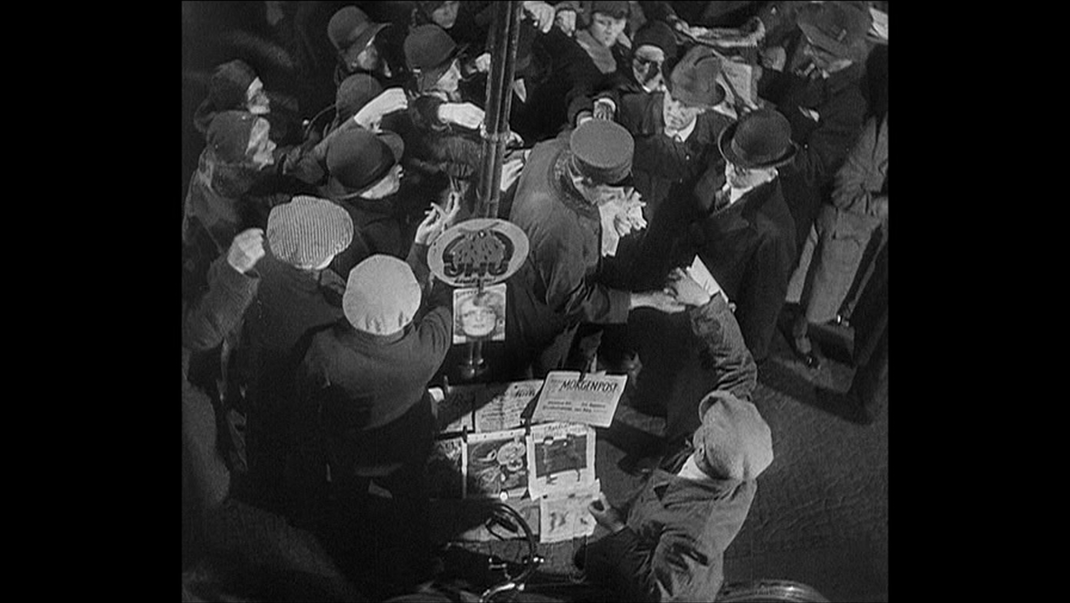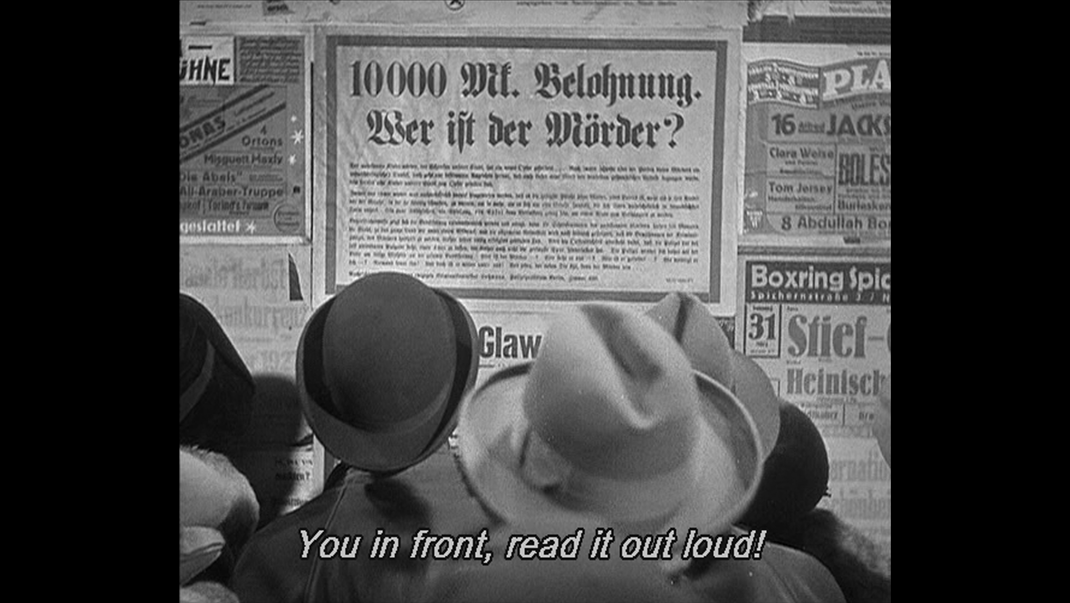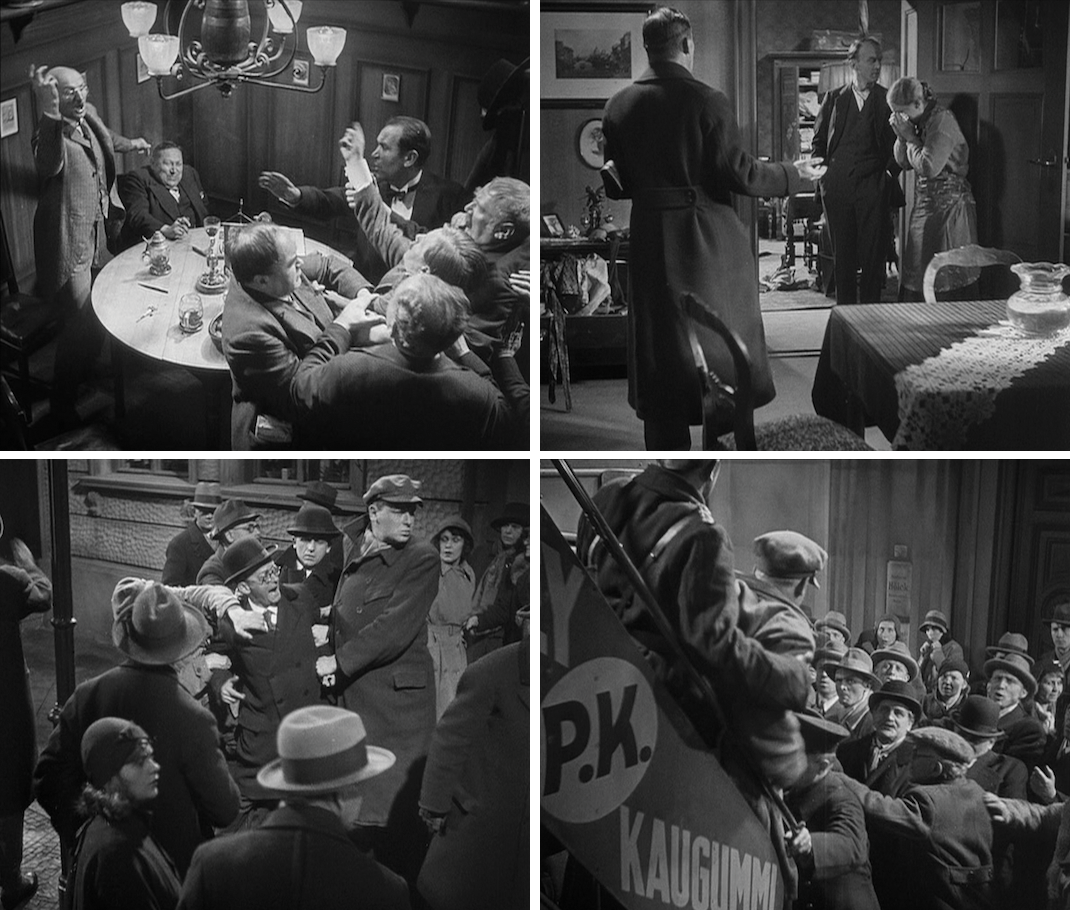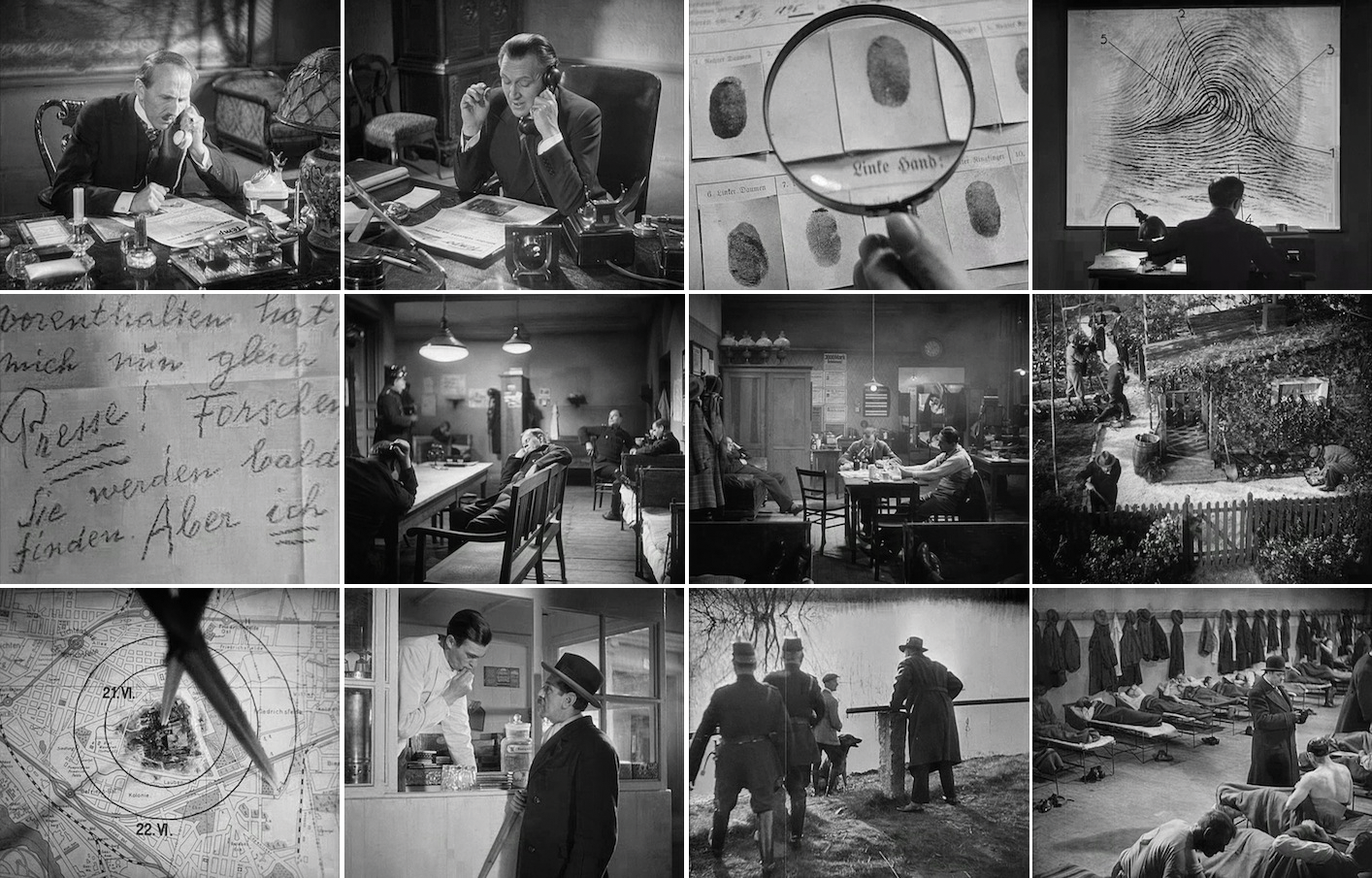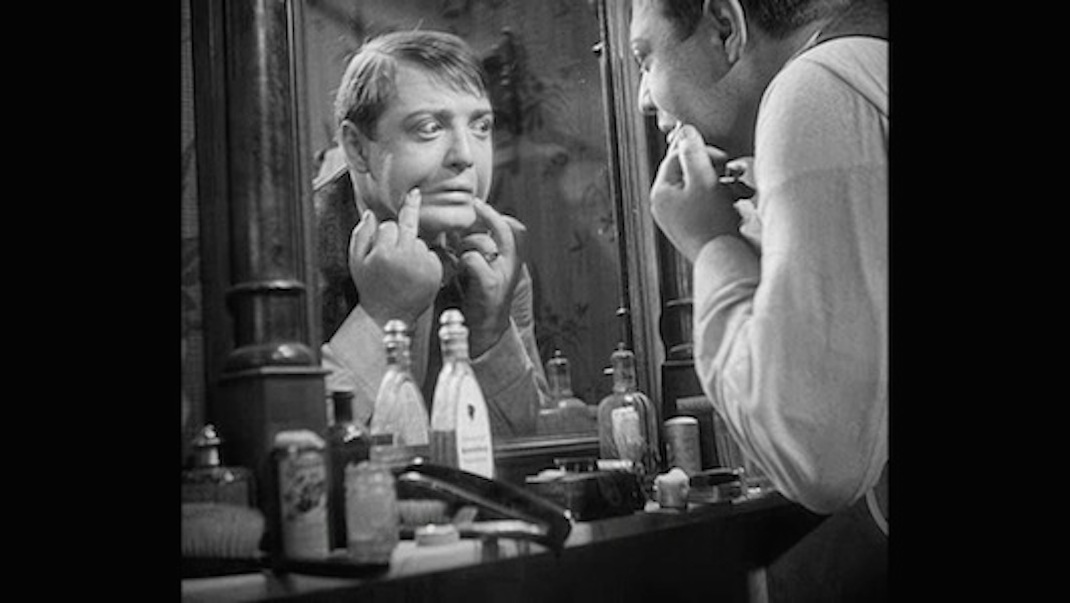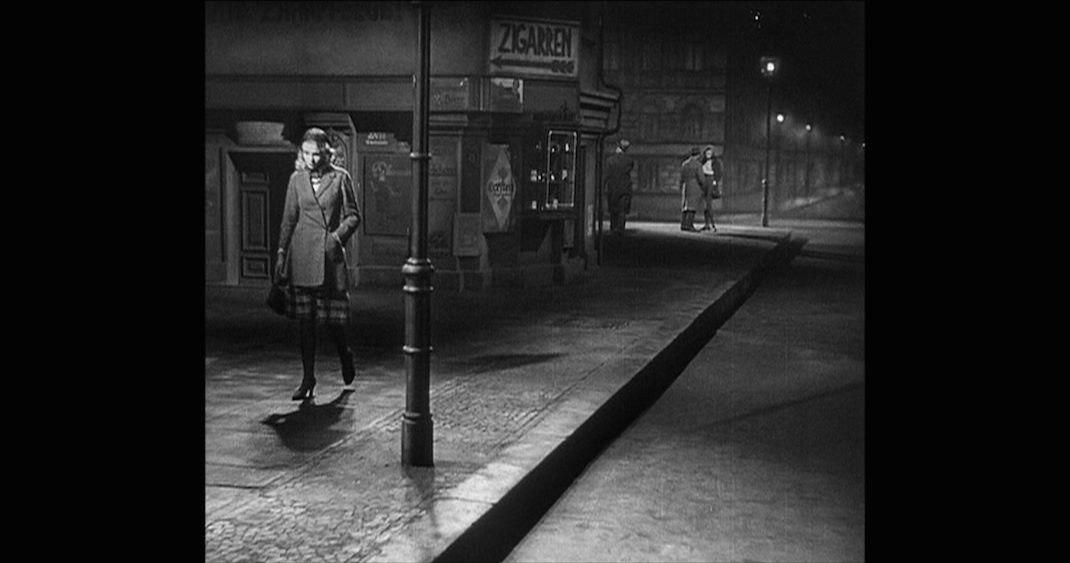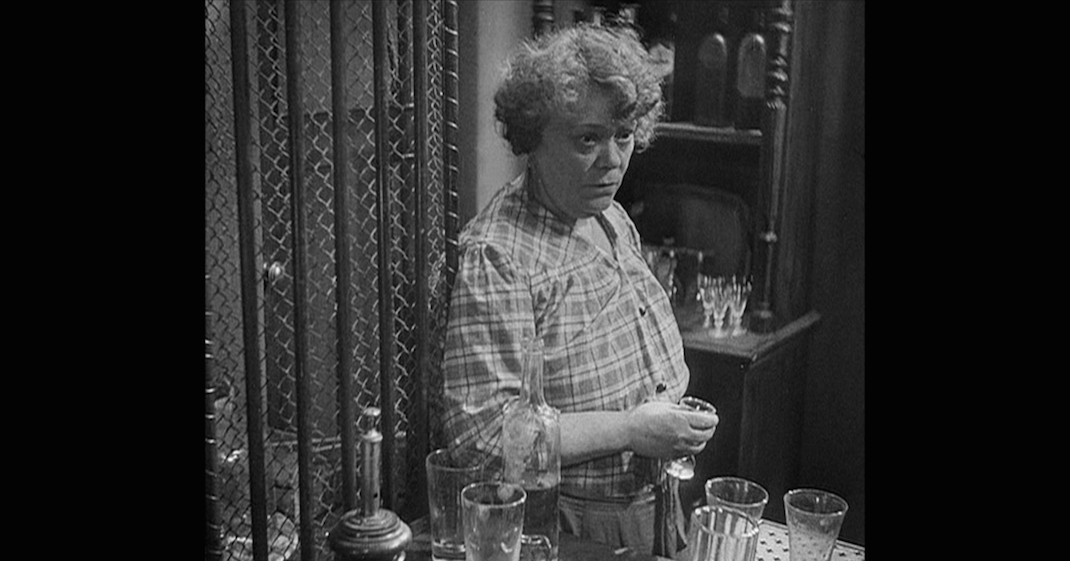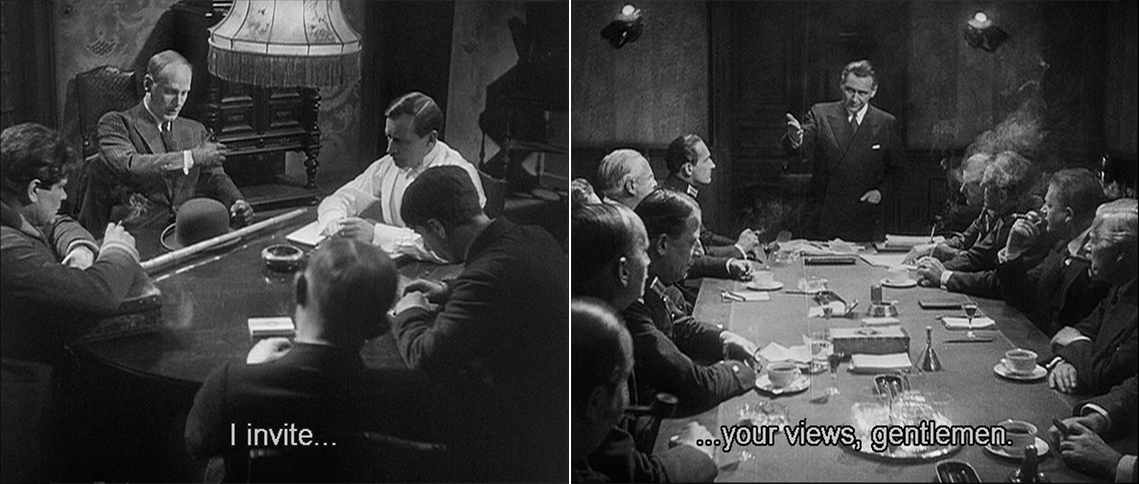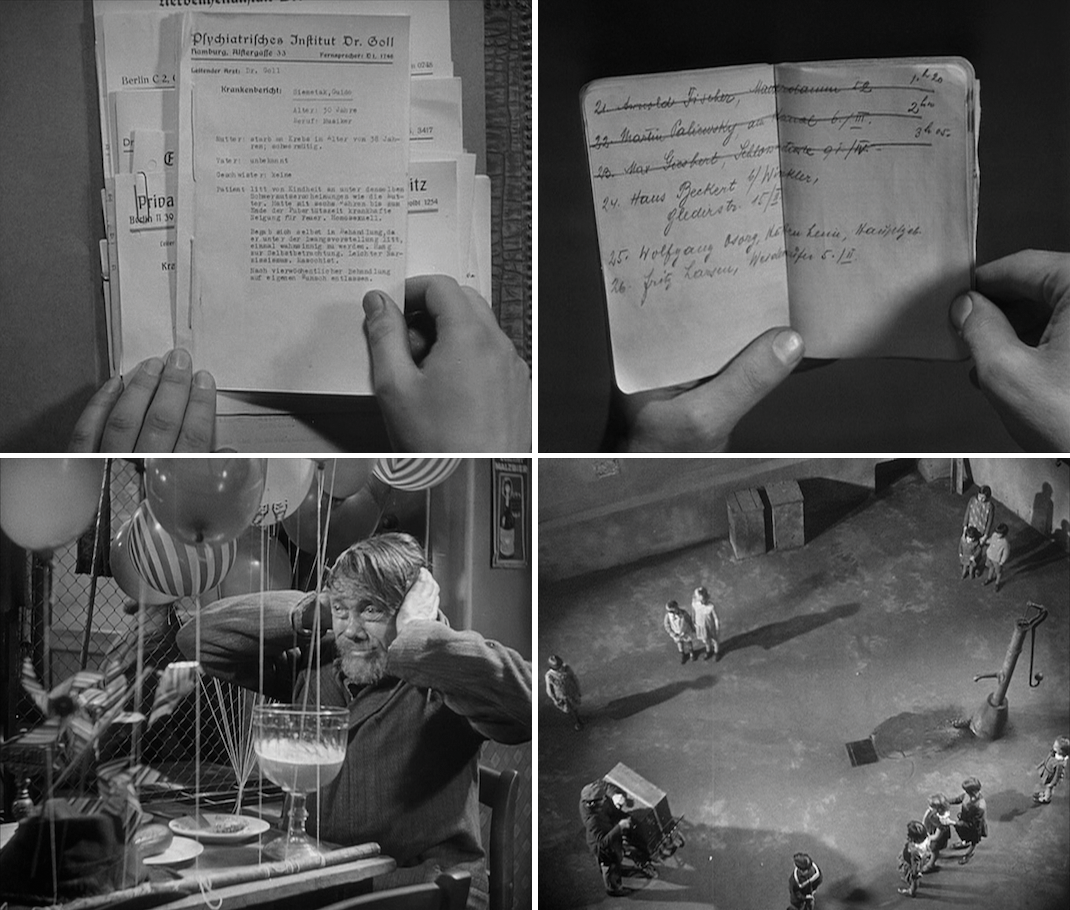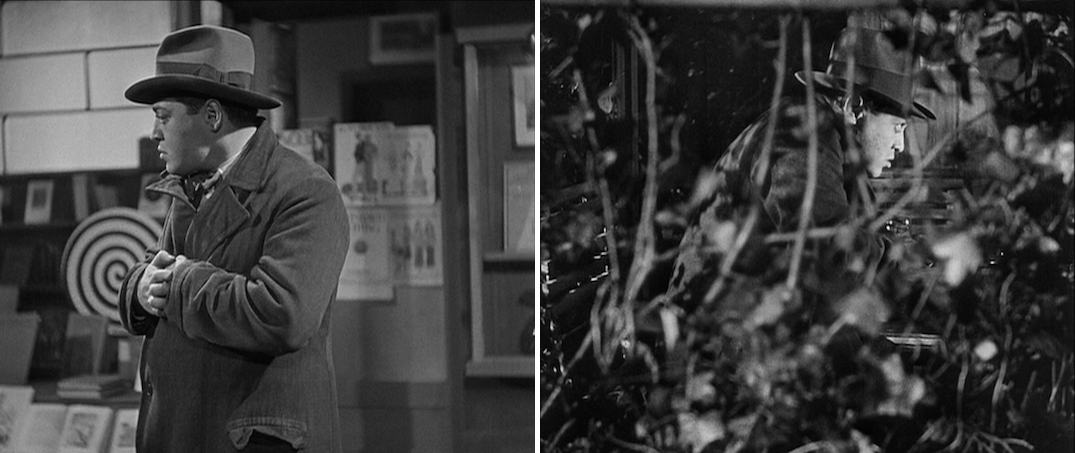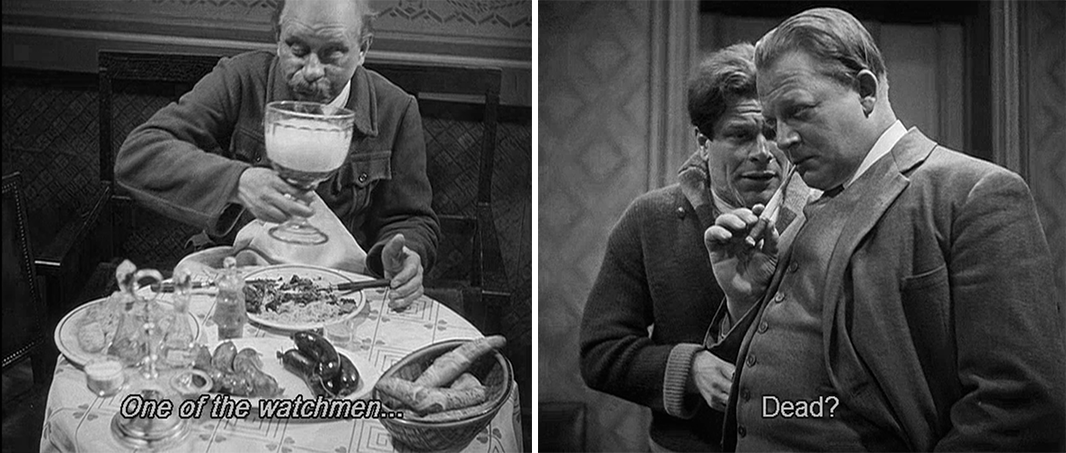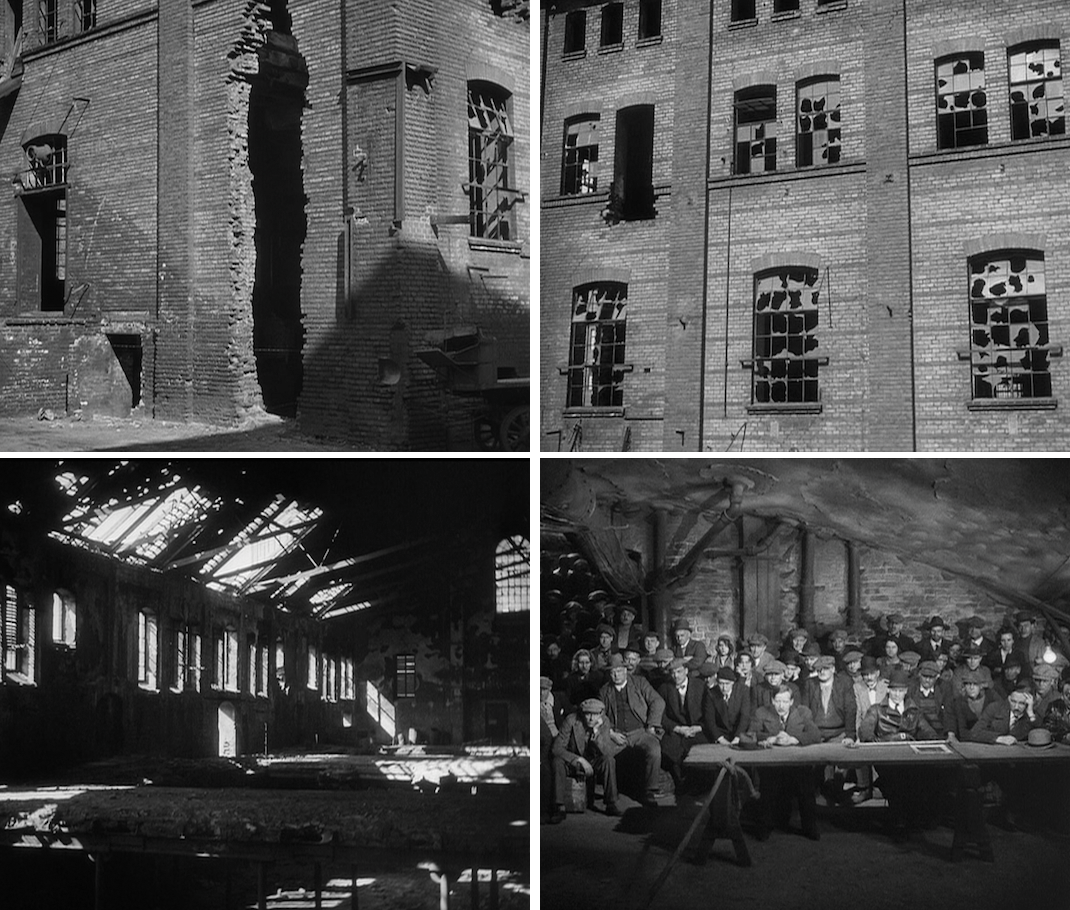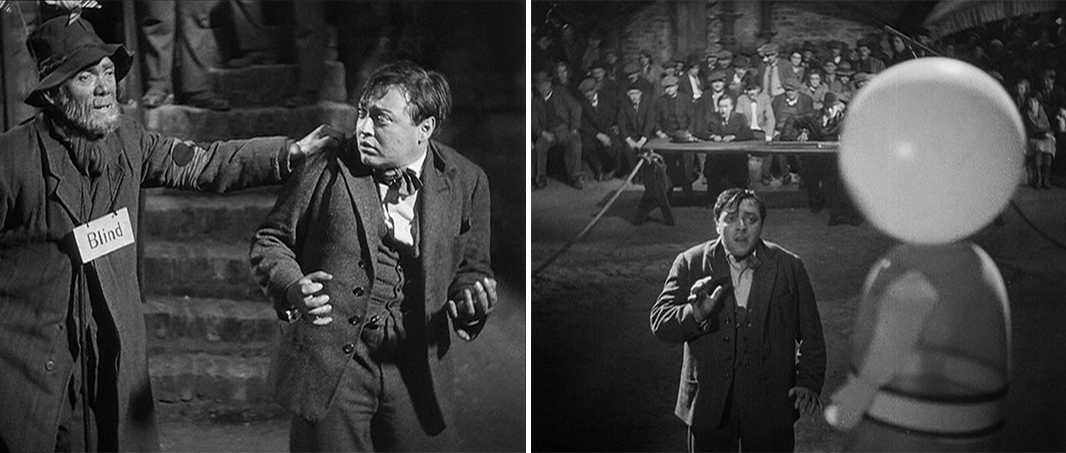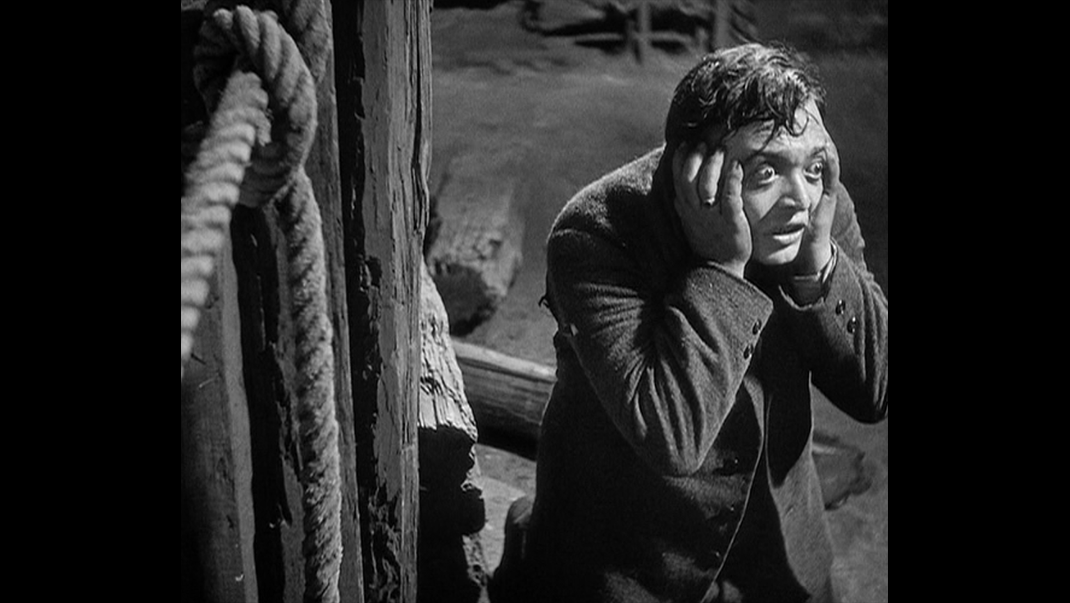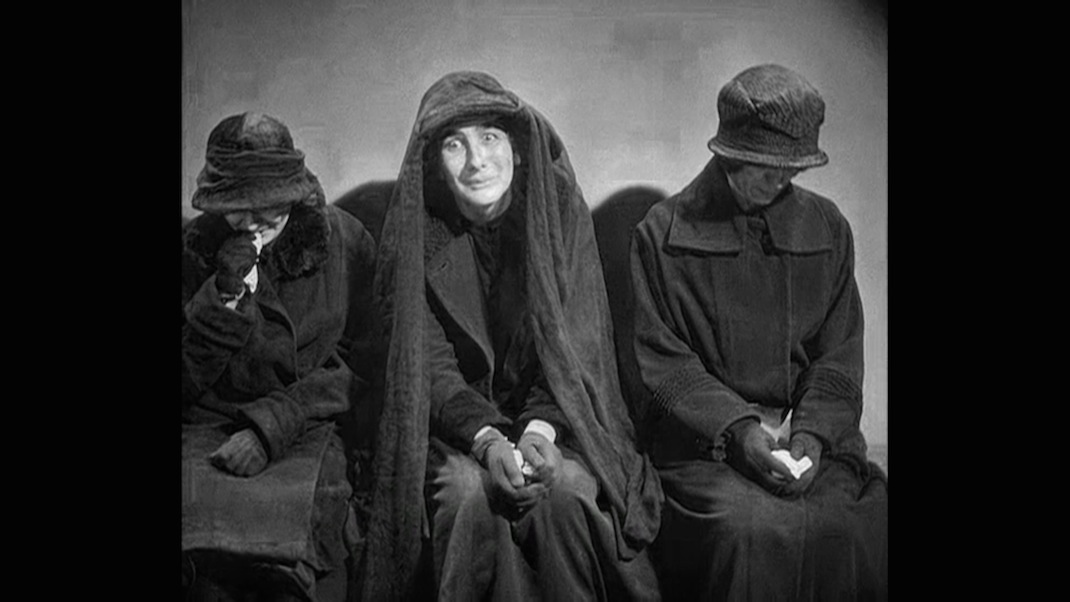In “Independent Study in World Cinema,” a self-educated film nerd attempts to fill in some fairly serious gaps in his self-education. In this eighth entry in the series, we celebrate the arrival of sound by whistling along with the Kindermörder in Fritz Lang's 1931 masterpiece M.
"It's going to make pictures about twice as human."
— Will Rogers, on the introduction of sound to movies.1
When I wrote the fifth post in this series, on The Passion of Joan of Arc, I mentioned how my arbitrarily selected journey through movie history sometimes gives me a little tunnel vision. "I have to resist the impulse," I said, "to view and discuss these works as if they were the first five movies in history, with each one adding another vital keystone to the foundation of film as we know it."
That temptation is going to be even harder to resist this week. And, honestly, I may not even try, because I'm really excited to talk about sound for the first time.
M was far from the first "talkie," of course. In America, The Jazz Singer (1927) had been a tremendous hit for Warner Bros, and had set off a commercial stampede that saw all the major Hollywood studios converting to sound by 1929. Europe was only slightly slower to follow suit: a few European productions began incorporating sound in the wake of The Jazz Singer, and its first genuinely successful talkie came with 1929's Blackmail, directed by an up-and-coming youngster named Alfred Hitchcock. By the time M premiered in May of 1931, sound was no longer such a novelty: in fact, it was the new normal.
But M was director Fritz Lang's first talkie. "At the time, there were hardly more sound films in Germany than you could count on the fingers of one hand," Lang said.2 And M, of course, is my first talkie for this series. So, though it's a great movie in every way—probably my personal favorite from the syllabus so far—in this reading I want to primarily focus on sound, and seize this opportunity to examine the workings of what was essentially a brand new art form.
And, as it turns out, M is the perfect movie for that purpose. In this transition period for cinema, when studios were shoving sound into movies that didn't need it for crass commercial purposes, Lang produced a masterpiece in which sound is not incidental or supplemental, but essential. Throughout the film we can see (hear?) Lang discovering the dramatic possibilities of this powerful new addition to the filmmaker's toolbox—and teaching other directors how to use it.
BACKGROUND
If one is to take Fritz Lang at face value—something that was, apparently, always a risky proposition—M almost didn't get made, because Lang had more or less decided to stop making movies. His relationship with Ufa, the state-operated German film studio, had soured after Lang refused to add sound effects to his previous film, the silent sci-fi melodrama Woman in the Moon (1929). "I said, 'No, it would break the whole rhythm, the whole idea,'" Lang told Peter Bogdanovich in 1965. "We had a big fight."3 Woman in the Moon flopped, Ufa stopped paying Lang, and Lang stopped wanting to make movies. "I was sick to here," Lang said, in a 1975 interview with William Friedkin. "And I wanted to become a chemist."4
But then Lang was approached by independent producer Seymour Nebenzal, who wanted a movie for his studio Nero-Film. Lang—sick of producers, and "sick and tired of big films like Metropolis"— finally agreed on the condition that he could make a movie on his own terms. He'd take Nebenzal's money, but nothing else: no input on the script, no interference with casting, no final cut. "I wanted to have a personal film, a film that deals with one human being, with one social evil," Lang said. "And so I made M.”5
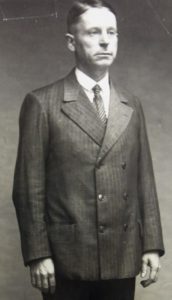
Lang and his wife Thea von Harbou—who wrote or co-wrote all of Lang's movies from 1920–1933—decided they wanted to focus on the "ugliest, most utterly loathsome crime" imaginable.6 The newspapers at the time were full of stories about the terrible crimes of the so-called "Vampire of Düsseldorf," who turned out to be a serial rapist and murderer named Peter Kürten. Kürten—who was arrested in 1930, and executed in 1931—committed a series of murders and sexual assaults over a period of 17 years. Many of his victims were very young girls.
Lang denied that the Kürten case was a particular influence on M, citing several other cases that featured "a strange similarity of events, circumstances that repeat themselves almost as if natural laws were at work."7 However, given the many similarities between the real case and the fictional one, I think this is another instance where we have to take Lang's recollections with a grain of salt. (Like Kürten, Hans Beckert—Lang's fictional murderer—would stalk young girls. Like Kürten, Beckert would write to the newspapers to boast of his crimes, using a red pencil where Kürten had used a blue one. During the search for Kürten, the police made an appeal to the criminal underworld for assistance; in M, it is the criminal underworld that ultimately catches the murderer.8)
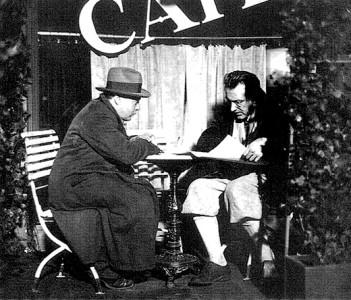
Whatever his inspiration, Lang found the man to play his Kindermörder in Peter Lorre, a Hungarian-born improvisational stage actor in his first major screen role. (Lang chose him, he said, “Because I thought nobody would believe that a human being looking like Peter Lorre would commit horrible murders.”9) Filming was completed over a period of six weeks at a studio outside of Berlin, using a cast that included several actual criminals. (Lang recounted to Friedkin that several of his "actors" in the final, kangaroo court scene told him they would have to leave because the police would be there in an hour. Lang—committed to finishing his picture—convinced them they could therefore afford to give him fifteen more minutes. "So we shot two more scenes, and then they left," Lang said.10)
The film premiered in May 1931, to enthusiastic audiences. As it followed so closely on the trial of Peter Kürten, a few critics panned it as headline-chasing sensationalism. ("The murder film M is the swiftest opportunism," wrote Gabriele Tergit, in Die Weltühne. "The beast was just in court, and already on the screen!"11) But this probably helped the film's commercial prospects, and M went on to be one of Lang's biggest hits, achieving worldwide success.
(It also reportedly contributed to Lang being summoned in 1933 to the offices of the Third Reich's Minister of Propaganda, Joseph Goebbels, and being offered the job of overseeing Germany's entire film production industry. According to Lang—in a very dramatic story that does not quite gibe with historical evidence—he nodded very politely, asked for 24 hours to consider the offer, and then fled to Paris the very same evening with little but the clothes on his back.)
Like almost every movie we've considered so far, the physical film of M would be shortened, censored, cropped, and damaged over the years, making the search for a pristine, unaltered print a tricky one. Since it was a "talkie," it also underwent new forms of indignation and bastardization. Sound created translation problems for foreign distribution, so versions of M exist in which dialogue and on-screen text are replaced for different markets, or with scenes recast and reshot with different actors. (Lorre even re-filmed his famous final monologue entirely in French. Whether Lang was involved in any of this is uncertain, but doubtful.)
M also features an unusual film ratio. The process used at the time embedded the audio track on the edge of the filmstrip, which took up space and narrowed the available screen area to an almost-square 1.19:1. This led to more cropping, and created additional problems for the various restoration attempts over the years. (This version on YouTube, for example—though otherwise very clean—suffers from cropping, and there is a white band at the top left by restoration equipment that couldn't handle M's aspect ratio.)
But a negative of the original print was discovered in the late 90s: it was missing one reel, but a major restoration was undertaken by archivist Martin Koerber in 2000, using the best available footage from various sources. It is this restoration that is on the Criterion Collection DVD I watched, and it's pretty damn good. (An apparently even better restoration made the rounds in theaters in 2013—restoring 7 minutes of previously lost footage—but it hasn't been released on home video yet.)12
The cinematic legacy of Fritz Lang was probably already assured with 1927's Metropolis, but—if you read my piece on that film—you will not be surprised to hear that I consider M to be, by far, the superior movie. So did Fritz Lang himself. (Lang didn't think much of Metropolis. In a 1967 conversation with the director Jean-Luc Godard, both men quickly agreed that the piece of art in Lang's filmography destined to live on and be enjoyed by modern audiences was M.)
I couldn't agree more. But enough prefacing: let's look at the film itself.
THE FILM
Sound comes first in Fritz Lang's M—literally. After the silent title card, and a card reading "A Film by Fritz Lang,"13 the screen fades to black and we hear the ominous sounding of a single gong. As film scholar Anton Kaes says on the Criterion commentary track, "Contemporary spectators would have associated this sound with the start of a newscast at the top of the hour. We are watching a reportage, and the clock is ticking." (Lang confirms this intention in his conversation with Godard: "I think the film M is a documentary," he says.)
As the gong sound fades, there is a silent black screen for one long moment, and then we hear a child's chanting voice:
Just you wait, it won't be long,
The man in black will soon be here.
With his cleaver's blade so true,
He'll make mincemeat out of you!
You're out!
We hear this child before he see her, and so in that brief moment of darkness we have begun to imagine her—a process of collaboration that Lang will utilize throughout M. What's more, the sound of the gong still lingers in our ears, and it is linked aurally to the child's rhyme—Just you wait, it won't be long—in a way that makes us think, as Kaes points out, "the clock is ticking." This is then married visually to the first shot of the film, which fades in: an overhead view of children arranged in a circle. It is a counting rhyme for a game, a process of elimination: the girl in the middle is turning as she recites the rhyme, pointing with her hand like the hand of a clock.
We have discussed various forms of montage in these posts, but clearly this is something new. It is a variation of Eisenstein's concept of intellectual montage, achieved not through the collision of two different images but through the collision of sound with image. By itself, in a silent film, the image of the children would be innocent. But sound provides the sinister nature of the rhyme, and marries the innocent image—and the disturbing suggestion of elimination—to the ominous tone of the newscast. The two components work together to evoke the concept of time, and to give a sense of pressing, urgent danger surrounding the childrens' existence.
And watch how Lang reinforces this dread: in the first of many unbroken tracking shots in the film, the camera moves up and away from the children, across the empty space of the courtyard, to find a washerwoman on a balcony above. The sound of the child's voice carries over with the camera movement: we are seeing the sound of her voice reaching an adult, who reacts with horror. "I told you to stop singing that awful song!" she yells at them. "Didn't you hear me?" Through the linkage of sound and image, adult fears have been linked to the innocence of childhood. The camera lingers on the empty balcony as the woman walks away, and for a moment there is silence—and then we hear the child begin her rhyme again.
But the transition has been made: we have been handed off to the role of the adult overseeing the children, and in the next shot we are with the washerwoman as she climbs the stairs of the apartment building. (Again, sound is used as a transition: we hear her climbing the empty staircase before we see her.) She rings the buzzer of a door—the sound signaling another passing of the focal point—and it is opened by Frau Beckmann (Ellen Widmann), who takes the clothes—and the narrative burden—from the first woman.
And here we also have the first appearance of a trope that occurs throughout the film: how sounds can be both negative and positive, ominous and reassuring, used for both good and evil. The first woman complains about the horrible song the children are singing, but Frau Beckmann disagrees. "Ah, leave 'em alone," she says. "As long as we can hear 'em singing, at least we know they're still there." What was threatening to one woman is comforting to the other.
(Half of the second such example of the duality of sound follows almost immediately, though its functional loop won't be closed for a few minutes. Frau Beckmann hears her cuckoo clock strike twelve, looks up at it, and smiles, because it means her daughter should soon be home. In just a few minutes, however, this same sound—now comforting—will be transformed into something ominous.)
But first, that cuckoo clock's sound has other work to do: it transitions us into a street scene, fading into the ringing of a much louder and deeper bell marking the hour. Parents stand outside a school as the clock strikes twelve, waiting for their children. This sound then carries us back to Frau Beckmann, awaiting her daughter: she can hear the bell, but slightly more quiet, through her kitchen window.
I am dwelling on all of this because—well, because I'm a film geek, and I'm geeking out. But I can't help it: I think these simple tricks with sound are unbelievably exciting. In our last post we discussed a few reasons to lament the passage of the silent film, but here I want to wholeheartedly celebrate the arrival of the talkie. The way Lang uses sound to transition between people, spaces, and even moods is absolutely thrilling to me. He even uses it practically, to provide relational information. (For example, the bells are loud outside the school, but softer when they reach Frau Beckmann's apartment: thus, Lang establishes the distance Frau Beckmann's daughter must traverse to come safely home.)
But we have already begun to suspect her daughter isn't going to make it. Lang establishes the first danger—of course—in the form of sound: as we see a little girl (Inge Landgut) wave goodbye to her friends, the sound of a car horn sounds—suddenly and loudly—from off-screen, causing the child to leap back onto the sidewalk. (Is this the first aural jump-scare in cinematic history, perhaps?) It's a simple but stunning way to not only suggest danger, but also to instruct the viewer how to watch a movie with sound. Pay attention, Lang is saying, to both the child and us: you can't rely on your eyes alone to know where the danger is.
Then we see this same child walking down the sidewalk, bouncing a ball: the sound of the ball hitting the pavement is in the same rhythm as the child's counting rhyme, connecting this scene to the marriage of innocence and danger inherent in the earlier one. (It is a game of elimination, and this child—as we shall soon see—is going to be out.) She pauses to bounce the ball against a kiosk, on which there is a poster offering a reward for information about the murderer. As she does this, the shadow of a man in a hat crosses the poster. (The camera has moved in, so we don't see either individual except by synecdoche: the ball, and the shadow, representing the child, and the danger, making both feel somehow more universal than specific.)
The man, of course, is Lorre's Hans Beckert, but we don't see him yet: we only hear his voice. "What a pretty ball you have there," he says. "What's your name."
"Elsie Beckmann," the little girl says.
We cut back briefly to Frau Beckmann, making Elsie's lunch. She looks at the clock—now reading 12:20—but she is not yet terribly worried. (She does not yet know—though we do—that her worst fears are about to be realized.) Lang's silences are every bit as important as his noises: both are deliberate, and each can be used for either comfort or distress. Here, Frau Beckmann's apartment is quiet: it is the safe haven that Elsie is trying to reach, away from the noisy dangers of the outside world.
Then Lang gives us a specific sound cue to represent that danger. We still have not seen the face of Lorre's character, but we see him from behind, buying a balloon from a blind peddler for Elsie Beckmann. And we hear him whistling: Edvard Grieg's "In the Hall of the Mountain King," from Peer Gynt. (What John Williams's Jaws theme is to the shark, "In the Hall of the Mountain King" is to Hans Beckert.) That the peddler is blind will be important, of course, in a film where what we hear is as important—or more important—than what we see.
If you'll forgive a digression, I should pause here for a word about how music functions in M. Film studies separate music in movies into two categories: diegetic and nondiegetic. Diegetic music comes—or is implied to have come—from a source within the story. (If there is a song in a scene because a character is playing the radio, for example, that is diegetic music.) Nondiegetic music, then, does not come from a source on-screen: it is not part of the story, but something that has been laid over the story to enhance our viewing experience. (To put it another way, we hear nondiegetic music, but the characters do not.)
M—significantly—features no nondiegetic music: in contrast to silent films where all we heard was external music as ornamentation to visuals, everything we hear in M emanates from within the story. I think this achieves a couple of important, related effects. First, it enhances the realistic "documentary" effect Lang was after. Second, it reinforces that every sound we do hear is deliberate, and important. At a time when superfluous sound effects and musical numbers were being shoehorned into silent films for commercial appeal, Lang is insisting on sound as a storytelling device. Every sound is an artistic choice: it is not just noise.
(A further digression, but an interesting one: in his book Overtones and Undertones: Reading Film Music, scholar Royal S. Brown argues that "In the Hall of the Mountain King"—though clearly diegetic—functions here almost as a nondiegetic theme for Beckert himself: he is almost providing his own soundtrack for the movie playing in his twisted mind as he stalks the children. "It is as if the villain uses diegetic music to create a quasi-nondiegetic score to accompany the narrative he […] is trying to control," Brown writes.14)
But let us get back to poor Frau Beckmann, for whom sounds have gradually become sources of anxiety. When she hears children on the stairwell, she is relieved, until she realizes her daughter is not among them. When she hears a knock on the door, she is hopeful, until it turns out to be a neighbor bringing her a magazine. When she is startled by the cuckoo clock again—now striking 1:15—the function of this sound has changed: where before it meant comfort, now it means that something is seriously wrong.
And it is with sound that she fights back, in a last-ditch play to make noise comforting, not threatening. She goes to the window and begins calling, loudly, for Elsie. Ellllsiiiiieeee….Elllsssiiiieee….. Lang, however, cuts to several shots of completely still, empty spaces: the stairwell, the attic, the empty chair where Elsie should by now be sitting. Frau Beckmann's voice, increasingly hysterical, echoes through these starkly empty spaces, but no reassuring sound comes back to comfort her. Now, there is only indifferent silence.
And then, finally, we cut to two more empty spaces, somewhere Frau Beckmann's voice cannot reach. First, we see a grassy area, barren, into which Elsie's ball rolls and comes to a sad and final stop. Next, we see some power lines, into which Elsie's balloon has been helplessly caught. Lang does not show—or even tell—what happens to Elsie Beckmann, or any of the Kindermörder's victims. And, like everything else in M, this is a very deliberate ploy to make the audience complicit in the story. "By not showing it, the whole audience, everyone in the audience, could think about the most horrible thing they could imagine," Lang explained to Friedkin. "And, therefore, the whole audience became a collaborator of mine.”15
So far I've only discussed the opening sequence of M: just the first eight minutes or so. It is sorely tempting to continue with a nearly shot-by-shot, sound-by-sound examination, but writing a book is not my goal here: I'm obviously going to need to pick up the pace a little bit, and discuss M a little more selectively.
It's difficult, though: M is the kind of flawlessly crafted movie that just makes my film-nerd heart sing. Even just focusing on the sound—which is how I'd planned to narrow my focus—I find exciting things happening in nearly every scene that I can't quite bear to ignore.
Take the next sequence (which I'll try to move through quickly, I promise). It opens with another black screen, serving as an act break, and once again we hear the next phase before we see it: a newspaper hawker, yelling out "Extra! Extra!" We fade up on an initially empty street, echoing the empty spaces with which Lang closed out the last act. Now, however, it is the newspaper man we hear echoing through this space, instead of Frau Beckmann's voice, and the space comes to life as the voice—which eventually becomes many voices—moves through it. The silence of Elsie Beckmann's death has exploded into noise in the community, bringing chaos and hysteria.
In the next shot the newspaper seller stands in the middle of a throng of people. Voices overlap here in the crowd scene—people saying things like "It makes you afraid to send your kids to school!"—but the hawker continues his chant of "Extra! Extra!" as he turns—clockwise—handing out papers. Shot from above, it is a deliberate echo of the opening shot of the little girl doing her counting rhyme, only now the field of play has shifted from the children to the adults.
Then we get a collision of video and audio that may seem simple to our modern eyes, but in historical context strikes me as Lang discovering sophisticated new storytelling techniques. We cut away—visually—from the newspaper man's sales pitch just as he hollers "Who is the murderer?" We hear him repeating this line, however, over the next shot, which is of a man sitting at a window sill, with his back to us, writing a letter. We hear "Who is the murderer?" a couple of more times, but growing softer, then fading out altogether as a new sound emerges: the man before us is whistling "In the Hall of the Mountain King." (The newspaper man's open question has been answered—for the audience—through this edit.) All noise of the outside world has faded away completely, and we are left with the murderer himself, safe and content in his own little world, removed from the consequences of his actions.
The Kindermörder is writing one of his letters to the newspaper, with his little red pencil. "Because the police did not publish my first letter, I am writing now directly to the press!" he writes. I'm not going to do much with the deliberate contrast between the written word and the spoken word in M., but I suspect it's a theme ripe for examination. It comes up again in the very next scene, in which a crowd gathers to read a new notice of a reward posted for information. "The print's too small," someone shouts. "We can't read it. You in the front, read it aloud!" It's another way that Lang, throughout the film, privileges sound over sight, culminating in how the murderer is eventually captured: the police will narrow in on him because of the letter, but he will be caught because of the whistling.
Now watch—and listen—to the dazzling sequence of scenes that follows. The voice of the man reading the notice transitions seamlessly to the voice of a man sitting at a table in a beer hall, reading the same notice aloud to his friends from the newspaper. "Anybody sitting next to you could be the murderer," the man reads. "Yes, that's very true," another man says, and casts a suspicious eye on a third man sitting at the same table. An argument breaks out, and then a fight, as the accuser—half-seriously—suggests the third man has a prurient interest in little girls. "Slanderer!" the taunted man shouts. "Trying to ruin my reputation!"
And off that line we cut to a completely different scene, in an apartment, where another man is yelling "Damn slanderer! Besmirching a man's good name!" This man is having a search warrant served on him by the police, due to some anonymous tip, and he's furious about it. The policeman explains why they have to follow up every lead: "Any man on the street could be the murderer," he says.
And in the middle of this line we cut to—naturally enough—a man on the street. This bespectacled old man is reading his paper (which—if we go back and look closely—we saw him buy from the hawker), as a little girl rides up to him on a scooter to ask him what time it is. He kindly tells her the time, but their conversation is seen—not overheard—by other people, who misunderstand its purpose. (Sight, again, is less reliable than sound.) A large man accosts the innocent old gentleman, and soon a crowd has swarmed around him, imagining that they have caught the murderer. "Call the police!" a man shouts.
Off this line, we transition to a bus, where the police are escorting a pickpocket into custody while a crowd watches. "Sure, you can catch pickpockets," the criminal complains. "Why don't you catch the murderer instead!" Here, it is sound that is misinterpreted as well as sight: the observing crowd overhears only the word "murderer," and assumes that the arrest they are witnessing is actually of the Kindermörder. They become a mob, attacking the pickpocket.
There's so much to love about this sequence. First, obviously, in the terms we've been discussing, it's just a fantastic technical display, with Lang editing sounds to serve as transitions between scenes. (It's almost the aural equivalent of eyeline matching, each line of dialogue providing a thread of continuity from one scene into the next.)16 But what's really amazing about it is that it doesn't just work technically: it also works thematically and emotionally. We are seeing—hearing—how the news of the murders has generated fear, which in turn has generated paranoia, which in turn leads to the chaos and violence of a mob mentality: sounds and words spread like a chain reaction throughout this community, from person to person and from place to place, capturing the panicked and paranoid mood of an entire city at bay.
(Something else worth noting about this sequence, and about M as a whole: it's funny. Silent film was a great vehicle for physical comedy, and we get some of that here, but we are also seeing the early potential of verbal comedy, of comedic nuance and timing in line readings. We are still a few films away from the first true comedy on our syllabus—1939's The Rules of the Game—but we're already seeing the expanded possibilities sound brought to the art form.)
What we see most impressively in M, however, is Lang embracing how sound allows for a quantum leap in the sheer amount of information cinema can convey. M is—among many other things—one of the first great police procedurals, and it provides a breadth and depth of information about how a criminal investigation is conducted that would have been impossible in silent film. (Compare the relative broad-stroke simplicity of the "detective story" in The Cabinet of Dr. Caligari to the rich, detailed realism of M.) And Lang achieves his almost documentary effect through the incredible efficiency of sounds working with images.
Take the next sequence in the film. It is little over six minutes long, but it covers the entire investigation, through the simple device of a phone call. A government official (Gerhard Bienert) calls up the police commissioner (Ernst Stahl-Nachbaur) to complain about the lack of progress in the case. As we hear their conversation, we see the various aspects of it they are discussing. We see the analysis of the fingerprints, and the study of the handwriting experts. We see the extra shifts being worked by the policemen and homicide detectives, and the scores of men searching crimes scenes for tiny scraps of evidence. We see interviews with candy store owners where the murderer may have bought sweets to tempt his victims, and arguments between supposed eyewitnesses who can't even agree on the color of the victim's hat. We see police rousting homeless shelters and railway stations for information. We understand the scope of the entire investigation in the span of a single phone call, because the dialogue succinctly walks us through the montage and makes sense of it for the viewer.
And we also understand that none of this is working: the police are no closer to catching the Kindermörder. (Lang gives us a quick reminder of this, in the middle of the investigation montage. As we hear a pompous handwriting expert explain that the murderer may be "acting" normal, while secretly displaying traits of madness, we see Peter Lorre pulling different faces in a mirror. It is our first real look at the murderer—we now know exactly who he is—but the disconnect between the image and the sound reminds us that the police have no clue.)
The phone-call montage also transitions us to the real heart of M, and to a different (and more effective) kind of investigation. We learn at the end of the call that one of the ineffectual things the police are doing is conducting raids on the criminal districts: vice squads are busting hotels and clubs of ill-repute, and rousting everyone they can find who may have information. From this information, Lang chooses—abruptly—to stop listening in on the phone call. The soundtrack goes completely silent for nearly 90 seconds, for we have entered another world, the secretive world of the criminal underworld. We see dark alleyways, empty rain-soaked streets, lonely prostitutes and furtive men in hats. (For all my focus on the sound in M, this is a good opportunity to point out that Lang's visuals—here, as throughout his career—are simply stunning: the man could light and frame the hell out of a moody, evocative shot.)
The silence of this world is shattered—appropriately enough—by a whistle. In this case, however, it is not the ominous musical theme of the murderer, but a sharp, piercing whistle of warning: it is a woman, alerting the gathered criminals in an underground club that the cops are coming to raid them.
In the interest of time and space I'm going to skip fairly quickly over this section, though it's full of as many delights as the rest of M. Essentially—as the lead detective in the case, "Tubby" Lohman (Otto Wernicke) checks everyone's papers—Lang provides us as comprehensive a tour of the criminal element as he did of the law-and-order crowd. We meet prostitutes and pickpockets, forgers and fur-thieves. In a long tracking shot, we see confiscated burglary equipment and weapons, as well as stolen jewelry, wallets, furs, and silverware, all laid out on a table. This world, too, is treated to Lang's "documentary" attention, for it is—and this is a theme of the movie—just as important a part of the community.
But what's really remarkable about this is that the criminals are every bit as human—in fact, more human—than the police and average citizens. The characters are funny, colorful, and real. And the bartender (Rosa Valetti) gets one of the most important speeches in the film, as she complains about how the police are ruining her business by hassling her customers. "They're human beings too," she says.
"You think we stay up all night for the hell of it? No. But you're drivin' away my clientele, and you won't find the guy you're looking for here anyway. If you knew how steamed they are at the guy who's causing these raids. Especially the girls. Sure, they solicit. Business is business. But believe me, in every one of them beats a mother's heart! I know a lot of toughs who get all teary-eyed just seein' the little ones at play. If they ever get their hands on the monster, they'll make toothpicks out of him!"
These people may be criminals, but they're not monsters: they are just people trying to live their lives, part of the community, as horrified as anyone at what has been happening. The Kindermörder is another class of being altogether, and against him they and the police are united on the side of humanity and decency.
Which is the point hammered home in the next extended sequence, as a council of five criminals—the "division leaders of the organization"—gather to plan a response to the disruption of their business. Their leader is a man called Safecracker (Gustaf Gründgens) who insists that "this state of affairs must end." Their interest are selfish, of course, but they are also driven by a communal spirit, and a desire to distinguish themselves from the sort of monster that kills innocent children. If cops and robbers try to kill each other, Safecracker says, that's fair: they both know the rules of the game. But, he says, "We must draw a firm line between ourselves and the man they're looking for!" Such a monster, he argues, must be killed, without mercy or compassion.
And here Lang does one of his fantastic transitions, to link the cops and robbers into one common goal. "I invite—" Safecracker begins, waving his hand to his comrades. Lang cuts instantly to a gathering of police and government leaders, where the police commissioner finishes both Safecracker's sentence and his gesture. "—your views, gentleman."
The conversation switches back and forth between the cops and the robbers, offering ideas on how to catch the murderer. The theme of communal responsibility is further underlined by this, in an ironic way: Tubby Lohmann complains about how worthless the help of the public is, and the gathered government agents agree that most of the public still doesn't think the murders concern them. "The idea that each individual is responsible for what happens to the poorest, most anonymous child on the street, hasn't even dawned on the public at large!" But it has dawned on the criminals: they—like the police—are talking through the night, trying to come up with ways to stop the monster.
Both sides come up with ideas that will pay dividends in this quest. The police decide to look at recently released mental patients. But the criminals' idea is better. "No child in this city must take a single step without us knowing it," Safecracker decides. They will blanket every square inch of the city with spies, and it must be people no one would notice: the beggars.
Over the next few scenes we see these two plans put into effect. The beggars begin their surveillance throughout the city, while the police begin tracking down mental patients. Here, again, is the dichotomy between sound and image, between speaking and writing. The police are embedded in text: Tubby Lohmann searches through stacks of medical files, and detectives follow up on names written in notebooks. The beggars, meanwhile, are more attuned to sound: blind beggars listen on street corners, and hurdy-gurdy men watch over the children from behind their instruments. (Note how the final shot here echoes the opening shot of the film: now a responsible adult is among the children, using a different musical theme to counteract the danger represented by the Kindermörder's whistling.)
This theme of the importance of sound is further emphasized when a detective, making his inquiries, actually arrives at the apartment of Hans Beckert, which we recognize as the murderer's apartment. He is focused on visual and textual clues: what newspaper does the man take? What surface does he write on? What does the paper in the wastebasket say? But at this point these clues are not enough to focus his attention on Beckert, and he is hindered by the fact that the only witness he speaks to—the man's landlady—is practically deaf. In the world of M, a blind man may—and in fact does—have the key to the mystery, but no one who can't hear sound can have any role to play in stopping the monster.
Meanwhile, the monster is out trawling for another victim. In the reflection of a store window, he spies a little girl, and nearly swoons with emotion. He follows her, and his "quasi-nondiegetic" theme music kicks into life as he begins whistling "In the Hall of the Mountain King" once again. (More logocentrism here: as he stalks her, the little is engrossed with the books in a store window, a focus on text that makes her oblivious to the danger represented by the Kindermörder's whistling.) He is drawing near to her—we do not see him, but we hear his whistling—when her mother arrives, having come to walk the girl home. The whistling abruptly stops, the monster's plan thwarted by a responsible adult.
And here Lang gives us a brief look at the turmoil within the murderer, the terrible needs and drives that he cannot control. A swirling display in the store window symbolizes the turmoil in Beckert's mind, which we see manifested as the man suddenly and desperately needs a drink. Shaken, he goes across the street to a cafe, and downs two swift cognacs as he tries to deal with the sudden thwarting of his urges. Sitting there, shot through a tangle of ivy like a jungle animal, he wrestles with his self-control. His whistling begins again: it is as wheezy and broken sound at first, but builds in volume and clarity as the man pulls himself together. The song's control of him reasserted, he rises suddenly and leaves, whistling.
And it is this that dooms him. The police would have caught him—we see Tubby Lohmann making a realization about physical evidence that will ultimately identify the murderer as Beckert—but the blind balloon peddler's epiphany is the one that will end the murderer's reign of terror. He hears Beckert whistling, and remembers: the man with Elsie Beckmann whistled just like that. He calls to one of his younger, sighted associates to spot the whistling man, and the young man sees that Beckert (off-screen) has acquired a new victim. Sight and sound, working together, have finally identified the Kindermörder.
We arrive at the sequence that gives the film its name, as the young man pursues Beckert and his new intended victim through the streets. He watches as Beckert buys sweets for the little girl, and in horror he sees Beckert pull out a knife. (But this is a visual misinterpretation: Beckert is just peeling an orange.) The blind man has identified an aural marker for the murderer, but the young man realizes that they need a visual marker as well, and he chalks a letter M on his palm. He bursts upon Beckert and claps him on the shoulder with this brand, pretending to chastise the man for littering. (This sequence has been largely silent, but now Beckert is startled and shaken as the man loudly yells at him: the hunter has become the hunted, and sound, as we will see throughout the remainder of the film, has become his enemy.)
The beggars keep watch on Beckert as he moves throughout the city, trading off to follow the man with the white M on his coat. The little girl eventually points it out to him, and Beckert realizes that he is being followed: the game is up. As he releases the girl, the beggar currently following him whistles loudly to alert his compatriots that the time to close the net is now. (Whistling has now turned against him: no longer as symbol of his power, it has become a symbol of his fear.) They chase him into an office building, and realize they have him trapped there as the building closes for the night.
Now M becomes yet another genre of film: a heist movie. But it's a most peculiar heist: Safecracker and his team break into the building, using their burglary skills not to steal anything, but in order to catch a murderer. In the interest of time I'm going to skip quickly through this fantastic sequence, but there are a few things worth noting related to our overall examination of sound in M.
Lang continues to use sound markers to structure the scene. Clock bells ring, marking the hour the "heist" is to begin. The men signal each other with whistles, having symbolically turned this tool on the murderer. When Safecracker needs information from one of the captured guards, we do not see how he gets it, but only hear a sharp cry from the man before he surrenders what he knows. As the men search through the building, Safecracker admonishes them "not to stomp around like elephants." Doors are wired with alarms, and a series of timeclocks throughout the building must be keyed, in order, to avoid setting off the alarm that will summon the police. Everything about this heist is about the careful control of sound.
And it is sound, once again, that dooms the Kindermörder: trapped in a storage area where he has hidden, Beckert uses his knife to pry a nail out of the wall, and then to bang this nail into something he can use to pick the lock. One of Safecracker's associates—making the rounds to tend to the timeclocks—overhears the light banging and scratching: he has found the rat trapped in the walls of the building.

As the men search the storage sheds for Beckert, the camera lingers on the cowering murderer as he hears his pursuers coming closer, and closer: he is the one now being stalked by sound. Meanwhile, a guard has managed to pull the alarm: interestingly, it is a silent alarm. The police are notified not through sound but through paper: a ticker-tape communication comes through a machine at the police station. Like everything else visual-and-text based, it leaves the police a day late and a dollar short: by the time they arrive at the building, Safecracker and his men have abandoned quietness, smashed loudly through the doors of the storage sheds, and captured the Kindermörder.
I'm going to skip over a scene in which Tubby Lohmann interrogates one of Safecracker's associates, Franz (Friedrich Gnaß), who accidentally got left behind. It's a funny scene—both Gnaß and Wernicke are talented comic actors—and not entirely irrelevant to our purposes here. (Lohmann tries to make sense of what happened at the office building from the files—from the text—but he can't do it: it makes no sense. It is only getting a verbal explanation from Franz that brings the situation into focus. Also, Lang does some amusing juxtapositioning of sound and image: we hear Lohmann telling Franz that one of the guards died in the heist, while we see that same guard enjoying a meal and a big glass of beer.)
But let's move on, finally, to the climax of the film. Safecracker has taken the murderer to an abandoned factory, to face a trial before the entire assembled criminal community. (Lang transitions to this scene with a series of shot of silent, empty spaces, echoing those after Elsie's death. But now it is Beckert who is lost in this silence.)
Beckert—screaming almost hysterically—protests his innocence before this kangaroo court. "This whole thing must be a mistake!" he says. But as he does a hand descends on his shoulder, assuring him that there is no mistake: it is the blind peddler, the guarantor of Beckert's guilt through the certainty of sound. "You bought a balloon just like this for little Elsie Beckmann," he says calmly.
It's important to note, however, that sound alone is not what seals Beckert's fate. (He continues to deny the accusation.) He responds to images—the photographs Safecracker shows him, of the murdered children. He can't bear to look at them, and tries to flee the room in a panic. The men grab him, hurl him down the stairs, and from this point on Beckert no longer denies what he has done. His defense, instead, is that he had no control over his actions. "I can't help it!" he cries.
"Who are you anyway? Who are you? All of you? Criminals. Probably proud of it, too. Proud you can crack a safe, or sneak into houses, or cheat at cards. All of which it seems to me you could just as easily give up if you had learned something useful, or if you had jobs, or if you weren't such lazy pigs. But me? Can I do anything about it? Don't I have this cursed thing inside me? This fire, this voice, this agony? […] I have to roam the streets endlessly, always sensing that someone's following me. It's me! I'm shadowing myself. Silently…but I still hear it! Yes, sometimes I feel like I'm tracking myself down. I want to run—run away from myself. But I can't! I can't escape from myself! I must take the path that it's driving me down and run and run down endless streets! I want off! And with me run the ghosts of the mothers and children. They never go away. They're always there! Always! Always! Always! Except…when I'm doing it. When I…Then I don't remember a thing. Then I'm standing before a poster, reading what I've done. I read and read…I did that? I don't remember a thing! But who will believe me? Who knows what it's like inside me? How it screams and cries out inside me when I have to do it? Don't want to! Must! Don't want to! Must! And then a voice cries out, and I can't listen anymore! Help! I can't! I can't! I can't! I can't!"
There is more worth discussing after this climactic scene, of course, including a debate over capital punishment, and a last line that Lang said was his entire reason for making the film. (As Beckert—whom the police do arrive in time to save from vigilante justice—is being sentenced by the court, Lang cuts away, and we do not hear the sentence. Instead, we see and hear a grieving mother, sitting outside the courtroom. "This will not bring our children back," she says. "One has to keep closer watch over the children. All of you!" This was Lang's true message in M, that theme—expressed by the bartender, and by Tubby Lohmann, and (in their own ways) by all the criminals: we are all responsible for the children. It takes a village to raise a child, and it takes a city to protect one.)
But I want to end this very long post by staying on Beckert's climactic monologue, because it is—more than all the dazzling editing gimmicks—the strongest argument for the quantum leap that sound represented for cinema.
It's an extraordinary monologue, performed with a feverish, mesmerizing intensity by Lorre. (Note how much of it is about hearing: he doesn't recognize his actions in text, but he is driven and tormented by voices, screams, cries.) In a silent film we might have gotten an intertitle reading "I can't help it!", and a few tortured shots of Beckert's face. But we would not have gotten this prolonged look at the nightmare of this man's soul, the lifetime of struggle, weakness, and wretchedness he lays bare on the grimy floor of that room. We would have had Lorre playing an emotion, but we would not have seen—let alone heard—the tortured progression of emotions he moves through in this scene: the anger and fear, the guilt and self-loathing, the horror and the ecstasy. (Compare the rich psychological accomplishment of Hans Beckert to the comparatively cardboard "villains" of our earlier films: Caligari, Orlok, Rotwang, etc. There is, of course, no comparison: those villains might have been more iconic, but that is because they were nowhere near as real.)
This sort of scene is a gift that sound brought to cinema. It is a gift to actors, who now, for the first time, have their full range of human expression. It is a gift to directors, who—as Lang does here—can largely leave the camera on his actor—with no intertitles to fragment the performance—but also cut away and show us how this speech is landing on the other people in the scene. (When Beckert says "the ghosts of the mothers and children," Lang cuts to the women in the crowd.) It is a gift to writers, who could now actually develop character and emotional arcs on page, not merely suggest them. And it is a gift to us, the viewers, who are given the opportunity to study fully realized characters on-screen for the first time.
I called Renée Falconetti's Joan of Arc "the first genuinely human character on film," and I meant it, but that was something different. Falconetti had only her face: her Joan had no voice. ("We didn't need dialogue," Norma Desmond says in Sunset Boulevard. "We had faces!") And it worked, because the silent films forced the audience to do half of the work. Falconetti and Dreyer made us empathize with Joan, and coaxed us into filling in the gaps around her with ourselves: we brought out own thoughts, our own emotions, our own experience of life and fear of death to project a person where there was only, in truth, a face. And, in some ways, perhaps, that was a purer artistic experience, a collaboration between artist and audience to achieve a more genuine empathy.
But the purity of that experience only really worked with simplicity: if we look at the other narrative films we've studied so far, we see they are filled with character types more than characters. People were wholly good, or wholly evil. Their motives were almost always clear, their actions unambiguous. We could argue about what such and such a character symbolized, but there was little complexity or ambiguity about their psychology. And the worlds they lived in were not, in the end, our world: they were places of pantomime and parable, evocations not representations.
M is something wholly different: it's a mirror, not a myth. We recognize its world, and we recognize that world's inhabitants. We see the detail, the messiness, the humor and horror, the cruelty and kindness. Even a monster like Hans Beckert becomes real: he is believable, recognizable, even—in moments—sympathetic. Sound and speech have provided the vital third dimension that had been missing from films, and the result is a masterpiece that is—as Will Rogers predicted—about "twice as human" as anything that had come before.
Next on the Syllabus
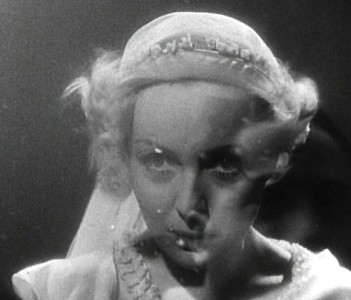 I'll be off in the middle of April—my wife and I are taking a belated honeymoon—but will return to this series with Jean Vigo's haunting love story L'Atalante (1934).
I'll be off in the middle of April—my wife and I are taking a belated honeymoon—but will return to this series with Jean Vigo's haunting love story L'Atalante (1934).
Then I am—with mixed feelings—squeezing in a late addition to the syllabus: Leni Riefenstahl's 1935 Nazi propaganda film Triumph of the Will. We'll follow that up with back-to-back masterpieces by Jean Renoir, Grand Illusion (1937) and The Rules of the Game (1939). Hope to see you here.
Notes
- Rogers, Will. “Talking Movies—A Prophecy that Came True,” Tulsa Daily World, June 10, 1928. Quoted in Eyman, Scott. The Speed of Sound: Hollywood and the Talkie Revolution 1926-1930 (Kindle Locations 6011-6014). Simon & Schuster. Kindle Edition.
- Gandert, Gero. “Fritz Lang on M: An Interview.” Marion von Schröder Vergag, 1963. Reprinted in the booklet for the 2004 Criterion Collection DVD of M.
- Bogdanovich, Peter. Who the Devil Made It: Conversations with Legendary Film Directors. Random House Publishing Group. Kindle Edition. (Kindle Location 3401).
- Friedkin, William. Conversation with Fritz Lang. Short film, included in the 2004 2-Disc Criterion Collection DVD of M.
- Ibid.
- Bogdanovich, Who the Devil Made It. (Kindle Location 3405).
- Lang, Fritz. “My Film M: A Factual Report.” Die Filmwoche, No. 21, May 20, 1931. Reprinted in the booklet for the 2004 Criterion Collection DVD of M.
- Hans Reutter, on his website cyberroach.com, convincingly traces many details from the film to a 25-page special bulletin about the “Vampire of Düsseldorf,” published by the Berlin police.
- Friedkin, Conversation with Fritz Lang.
- Friedkin, Conversation.
- Tergit, Gabriele. “Fritz Lang’s M: Filmed Sadism,” Die Weltühne 227, No. 23, June 9, 1931. Reprinted in the booklet for the Criterion Collection DVD of M.
- For more information on various issues and restoration attempts, see the short documentary “A Physical History of M” on the 2004 Criterion Collection DVD.
- Since I recently wrote about the erasure of women from film history, I feel obliged to point out here that Thea von Harbou received no on-screen credit in many of Lang’s films, including M.
- Brown, Royal S. Overtones and Undertones: Reading Film Music. University of California Press, 1994, 84–85.
- Friedkin, Conversation.
- A stray thought for my geekier readers: what Lang’s sound-as-transition trick most reminds me of is the way Alan Moore and Dave Gibbons handle transitions in their graphic novel Watchmen: the line from one scene leading into, and often taking on a completely different meaning in, another. It’s one of the things that people most often discuss when they trumpet the unprecedented sophistication of Watchmen, but it seems strange now that comics took more than 50 years to steal this trick from cinema.


